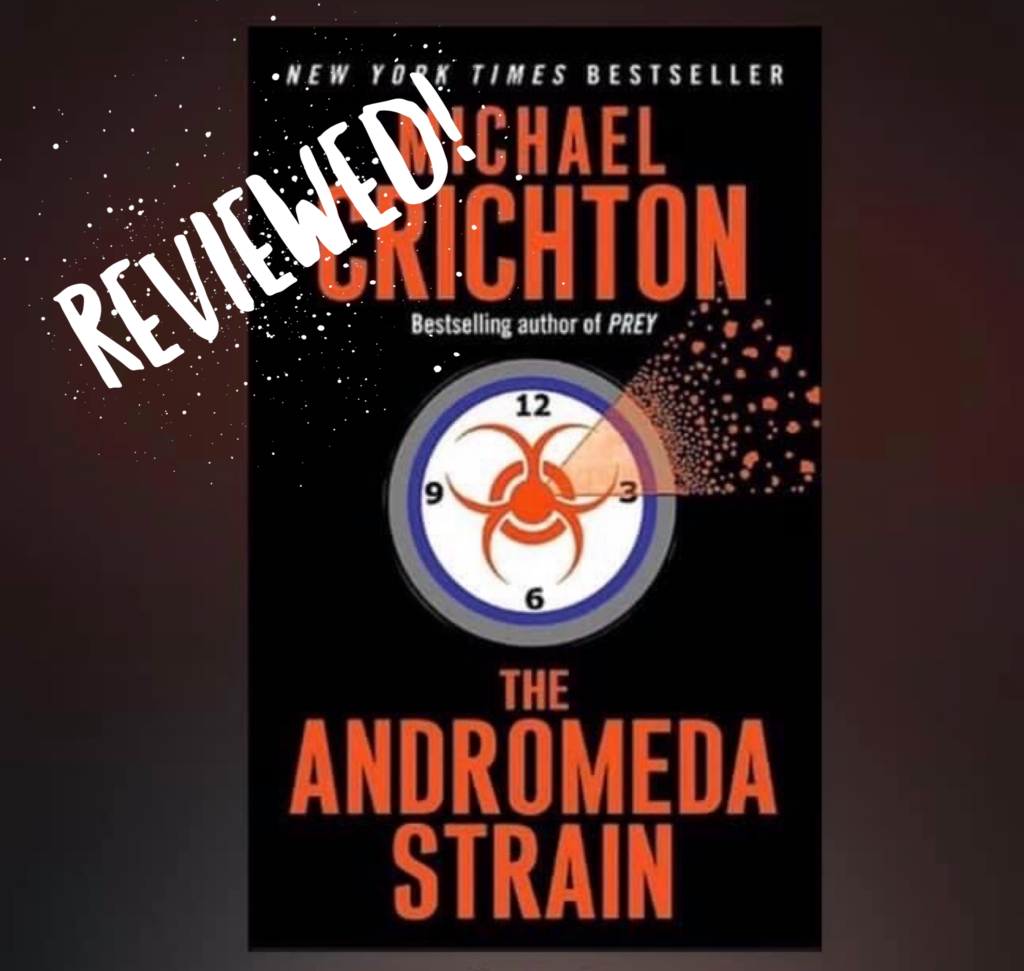
THE QUEUE Reading List Rating: 3 out of 5
It pains me to give any book written by the late, great Michael Crichton less than five stars. If you’ve ever read Jurassic Park, you know how Crichton gets the science fiction award for turning the world around on its head. I added this one to my reading list because I’ve enjoyed so many of his other works.
He injects his hard science fiction books with energy and pizazz, tackling the toughest of topics including mental health issues gone amok (Sphere), medical technology overstepping its boundaries (Terminal Man), and the ethical issues behind genetic testing (Jurassic Park… duh).
The Andromeda Strain is one of Crichton’s earliest works, written in 1969, and like the old clichéd “fine wine”, he got better with age. The novel poses the question of what we as humans would do in the event that an alien organism, in this case, a strain of bacteria, would make its way to the surface of our planet. How would we react? What would happen to us? What would happen to the organism?
Crichton’s take on this situation is… bizarre. Let me explain. Beware, spoilers ahead.
The organism in question, the Andromeda Strain (not named so because it came from the Andromeda Galaxy, rather a name produced at random by a computer program) is brought to the Earth’s surface by one of our very own space probes. The probe lands in a tiny town in the middle of the Arizona desert and promptly kills off every person in the town with the exception of two – an old man with a failing liver and a six-month-old baby.
At the discovery of the crash site, the government puts together a team of doctors and scientists to study the organism. These doctors travel to the remote location known as Project Wildfire, a state-of-the-art facility built deep into the ground of the desert, the Nevada desert this time.
The doctors and scientists, all men – this was 1969, of course – spend the next few days making their way through the meticulous levels of quarantine to the very bottom level of the Wildfire facility. Once there, they spend run tests on the sample taken from the space probe trying to figure out what the heck this thing is.
What they find is what really makes this story bizarre, in my opinion. The strain kills people by clotting their blood, either causing them to go crazy because of brain bleeding or causing them to die instantly as the blood clots in their hearts. The two survivors had special health circumstances that kept them immune to the strain.
But here’s the real kicker, the doctors realize that the strain has mutated and it’s totally harmless to humans – but it can now eat through rubber. Yes, you read that correctly – it can now eat through rubber.
Most of the action happens at the very end of the story when the strain eats through the rubber seals that guard the facility against contamination. Since the contamination has spread, the Wildfire computer puts into action the “self destruct” mechanism – an atomic bomb that will blow the Wildfire facility and all of its scientists to smithereens.
As you probably guessed, Crichton’s scientists figure out a way to prevent the atomic explosion and save everyone’s lives. The Andromeda Strain goes about its now-harmless way and eventually settles in the upper atmosphere in its mutated, rubber-eating form.
That would be the end of the story if not for the Epilogue which tells the brief story of the mutant, rubber-eating bacteria dissolving through the hull of a manned space vehicle, thus killing the astronauts as they tried to re-enter the atmosphere. The continuation of the story is yet to come and I would imagine that the sequel – The Andromeda Evolution – must pick up at that point. I’ll certainly let you know when I’ve read that one.
The idea of this story intrigues me, but the delivery of the story falls flat. There’s lots of science here, which, don’t get me wrong, is something I love. But this one goes a bit too far with scientific explanation making up the bulk of the writing. There’s barely room for the story.
One positive – Crichton does an excellent job of keeping you wondering. What is the strain and how will they eventually stop it? But the answers to those questions seem like an afterthought. The strain turns benign and only affects rubber? I’m sorry, but where did that come from?
I didn’t love this book. But it is very well-written and researched, as all Crichton books are. And it did keep me interested before falling flat at the end. There were some dead spots in the middle where I had to skip over big paragraphs of science just to get through to the next exciting part.
If you’ve read The Andromeda Strain, I’d love to hear your take on it. Leave me a comment and let me know!
And if you’re looking for a pared-down version of my book reviews, subscribe to my newsletter, THE QUEUE. I give you a short-and-sweet book review and discuss what’s up next in my reading and writing queue. I’d love to have you on board as a subscriber!
Thanks for stopping by!
Rebecca

